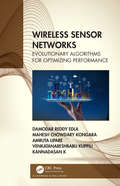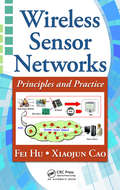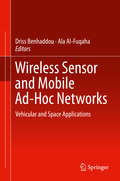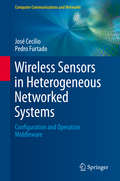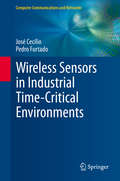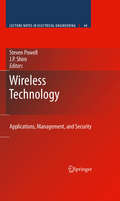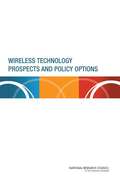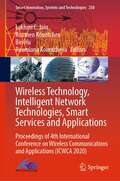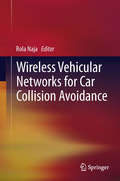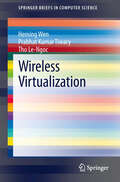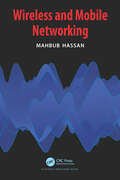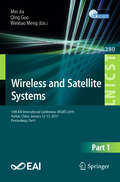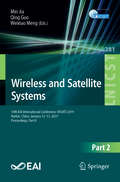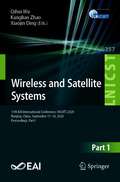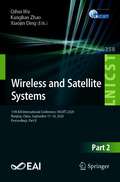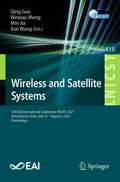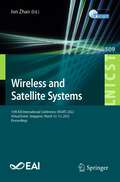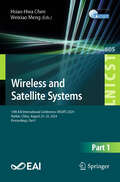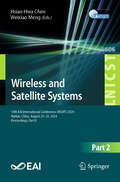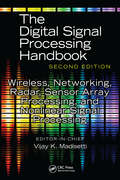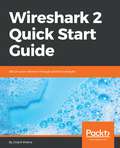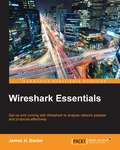- Table View
- List View
Wireless Sensor Networks: Evolutionary Algorithms for Optimizing Performance
by Damodar Reddy Edla Venkatanareshbabu Kuppili Mahesh Chowdary Kongara Amruta Lipare Kannadasan KWireless Sensor Networks: Evolutionary Algorithms for Optimizing Performance provides an integrative overview of bio-inspired algorithms and their applications in the area of Wireless Sensor Networks (WSN). Along with the usage of the WSN, the number of risks and challenges occurs while deploying any WSN. Therefore, to defeat these challenges some of the bio-inspired algorithms are applied and discussed in this book. Discussion includes a broad, integrated perspective on various challenges and issues in WSN and also impact of bio-inspired algorithms on the lifetime of the WSN. It creates interdisciplinary theory, concepts, definitions, models and findings involved in WSN and Bio-inspired algorithms making it an essential guide and reference. It includes various WSN examples making the book accessible to a broader interdisciplinary readership. The book offers comprehensive coverage of the most essential topics, including: Evolutionary algorithms Swarm intelligence Hybrid algorithms Energy efficiency in WSN Load balancing of gateways Localization Clustering and routing Designing fitness functions according to the issues in WSN. The book explains about practices of shuffled complex evolution algorithm, shuffled frog leaping algorithm, particle swarm optimization and dolphin swarm optimization to defeat various challenges in WSN. The author elucidates how we must transform our thinking, illuminating the benefits and opportunities offered by bio-inspired approaches to innovation and learning in the area of WSN. This book serves as a reference book for scientific investigators who shows an interest in evolutionary computation and swarm intelligence as well as issues and challenges in WSN.
Wireless Sensor Networks: From Theory to Applications
by S. Ramakrishnan Ibrahiem M. M. El EmarySupplying comprehensive coverage of WSNs, this book covers the latest advances in WSN technologies. It considers some of theoretical problems in WSN, including issues with monitoring, routing, and power control, and details methodologies that can provide solutions to these problems. It examines applications of WSN across a range of fields, including health, defense military, transportation, and mining. Addressing the main challenges in applying WSNs across all phases of our life, it explains how WSNs can assist in community development.
Wireless Sensor Networks: Principles and Practice
by Fei Hu Xiaojun CaoWritten by award-winning engineers whose research has been sponsored by the U.S. National Science Foundation (NSF), IBM, and Cisco's University Research Program, Wireless Sensor Networks: Principles and Practice addresses everything product developers and technicians need to know to navigate the field. It provides an all-inclusive examina
Wireless Sensor and Mobile Ad-Hoc Networks
by Driss Benhaddou Ala Al-FuqahaWireless sensor Networks: Vehicle and Space Applications describes the practical perspectives in using wireless sensor networks (WSN) to develop real world applications that can be used for space exploration. These applications include sensor interfaces, remote wireless vehicles, space crew health monitoring and instrumentation. The material discusses how applications of WSN originally developed for space travel and exploration are being applied and used in multiple real world applications, allowing for the development of smart systems that have characteristics such as self healing, self diagnosis, and emergency healthcare notification.
Wireless Sensors in Heterogeneous Networked Systems
by José Cecílio Pedro FurtadoThis book presents an examination of the middleware that can be used to configure and operate heterogeneous node platforms and sensor networks. The middleware requirements for a range of application scenarios are compared and analysed. The text then defines middleware architecture that has been integrated in an approach demonstrated live in a refinery. Features: presents a thorough introduction to the major concepts behind wireless sensor networks (WSNs); reviews the various application scenarios and existing middleware solutions for WSNs; discusses the middleware mechanisms necessary for heterogeneous WSNs; provides a detailed examination of platform-agnostic middleware architecture, including important implementation details; investigates the programming paradigms for WSNs, and for heterogeneous sensor networks in general; describes the results of extensive experimentation and testing, demonstrating that the generic architecture is viable for implementation on multiple platforms.
Wireless Sensors in Industrial Time-Critical Environments
by José Cecílio Pedro FurtadoThis book introduces the fundamentals of DCS, and shows how to include wireless technology in their design while guaranteeing the desired operation characteristics. The text also presents insights and results gained from extensive practical experience in implementing and testing systems within a specific industrial setting. Features: examines the operations that the DCS implements, covering human-machine interfaces, diagnostics and maintenance interfaces, and controllers; discusses industrial control system and wireless network protocols; reviews scheduling in wireless sensor networks; describes a latency model for heterogeneous DCS with wired and wireless parts, that predicts monitoring, command, and closed loop latencies; explains how to plan operation timings systematically; introduces measures and metrics for performance monitoring and debugging, and describes how to add these to a system; presents experimental results to validate the planning approach, based on an application test-bed.
Wireless Technology
by Steven Powell J. P. ShimThis is an edited volume based on selected papers from the annual Wireless Telecommunications Symposium. The WTS is a forum to exchange information on advances in mobile communications and wireless networking technology, management, applications, and security in a conference environment with leaders and experts from industry, governmental agencies, and universities around the world. The key topics from the symposium include: 1) Wireless Network Security, 2) Advances in Satellite Communications, 3) New Wireless Communications Ventures, 4) Wireless Communications Investments, 5) Mobile Wireless Services and Business, 6) Future Directions in Wireless Communications Research. The best papers from the conference were selected, expanded, and edited to produce this cohesive volume.
Wireless Technology Prospects and Policy Options
by National Research Council of the National AcademiesThe use of radio-frequency communication--commonly referred to as wireless communication--is becoming more pervasive as well as more economically and socially important. Technological progress over many decades has enabled the deployment of several successive generations of cellular telephone technology, which is now used by many billions of people worldwide; the near-universal addition of wireless local area networking to personal computers; and a proliferation of actual and proposed uses of wireless communications. The flood of new technologies, applications, and markets has also opened up opportunities for examining and adjusting the policy framework that currently governs the management and use of the spectrum and the institutions involved in it, and models for allocating spectrum and charging for it have come under increasing scrutiny. Yet even as many agree that further change to the policy framework is needed, there is debate about precisely how the overall framework should be changed, what trajectory its evolution should follow, and how dramatic or rapid the change should be. Many groups have opinions, positions, demands, and desires related to these questions--reflecting multiple commercial, social, and political agendas and a mix of technical, economic, and social perspectives. The development of technologies and associated policy and regulatory regimes are often closely coupled, an interplay apparent as early as the 1910s, when spectrum policy emerged in response to the growth of radio communications. As outlined in this report, current and ongoing technological advances suggest the need for a careful reassessment of the assumptions that inform spectrum policy in the United States today. This book seeks to shine a spotlight on 21st-century technology trends and to outline the implications of emerging technologies for spectrum management in ways that the committee hopes will be useful to those setting future spectrum policy.
Wireless Technology, Intelligent Network Technologies, Smart Services and Applications: Proceedings of 4th International Conference on Wireless Communications and Applications (ICWCA 2020) (Smart Innovation, Systems and Technologies #258)
by Lakhmi C. Jain Bin Hu Roumen Kountchev Roumiana KountchevaThis book gathers selected papers presented at the 4th International Conference on Wireless Communications and Applications (ICWCA 2020), held at Hainan University, China. The second volume will involve research works aimed at the contemporary applications: emerging wireless/mobile applications, context and location-aware wireless services; wireless telemedicine and e-health services; intelligent transportation systems; RFID technology and application; cognitive radio and sensor-based applications; content distribution in wireless home environment and many others.
Wireless Vehicular Networks for Car Collision Avoidance
by Rola NajaWireless Vehicular Networks for Car Collision Avoidance focuses on the development of the ITS (Intelligent Transportation Systems) in order to minimize vehicular accidents. The book presents and analyses a range of concrete accident scenarios while examining the causes of vehicular collision and proposing countermeasures based on wireless vehicular networks.The book also describes the vehicular network standards and quality of service mechanisms focusing on improving critical dissemination of safety information. With recommendations on techniques and protocols to consider when improving road safety policies in order to minimize crashes and collision risks.
Wireless Virtualization
by Tho Le-Ngoc Heming Wen Prabhat Kumar TiwaryThis SpringerBriefs is an overview of the emerging field of wireless access and mobile network virtualization. It provides a clear and relevant picture of the current virtualization trends in wireless technologies by summarizing and comparing different architectures, techniques and technologies applicable to a future virtualized wireless network infrastructure. The readers are exposed to a short walkthrough of the future Internet initiative and network virtualization technologies in order to understand the potential role of wireless virtualization in the broader context of next-generation ubiquitous networks. Three main wireless virtualization perspectives are explored, along with the potential challenges and requirements of a sustainable wireless virtualization framework. Finally, it presents an example of a multi-perspective wireless virtualization framework. The readers learn the latest concepts in the application of wireless virtualization as well as its relationship with cutting-edge wireless technologies such as software-defined radio (SDR) and cognitive radio.
Wireless and Mobile Networking
by Mahbub HassanThere has been phenomenal uptake of wireless and mobile networking technologies in the past decades. Significant developments have taken place during this time making the wireless technology more affordable, effective, and reliable. This book explains the fundamental principles and protocols of key existing and emerging wireless networking technologies. The book begins with a review of the fundamentals of wireless communications. It covers the basic theories and terminologies of coding and modulation, which maps digital information to the underlying signal, as well as the models to capture the dynamics of wireless signal propagation in the environment. It provides in-depth coverage of the WiFi evolution covering both the mainstream WiFi, which operates in 2.4/5GHz with new versions targeting 6GHz, as well as some of the niche WiFi standards that operate outside the mainstream bands such as 802.11af in 700MHz TV bands, 802.11ah in 900MHz to connect the Internet of Things (IoT), and 802.11ad/ay in 60GHz to support multi-gigabit applications. The book covers the fundamental concepts of cellular networks, examines the advancements brought forth by each generation, and discusses new applications and the underpinning wireless technologies promised by 5G. It also covers a recently developed long-range low-power wireless networking technology called LoRa, which is the fastest growing technology to connect millions of IoT sensors and devices throughout the world. The concluding chapters examine emerging wireless paradigms such as Artificial Intelligence for wireless networking, sensing with wireless signals, and mobile networking with flying base stations carried by drones and unmanned aerial vehicles (UAVs). With many worked-out examples, illustrative figures, and multiple choice questions, this book is an ideal for students and a valuable reference for anyone working in this rapidly evolving field.
Wireless and Satellite Systems: 10th EAI International Conference, WiSATS 2019, Harbin, China, January 12–13, 2019, Proceedings, Part I (Lecture Notes of the Institute for Computer Sciences, Social Informatics and Telecommunications Engineering #280)
by Weixiao Meng Min Jia Qing GuoThis two-volume set LNICST 280-281 constitutes the post-conference proceedings of the 10th EAI International Conference on Wireless and Satellite Services, WiSATS 2019, held in Harbin, China, in January 2019. The conference was formerly known as the International Conference on Personal Satellite Services (PSATS) mainly covering topics in the satellite domain. The 137 full papers were carefully reviewed and selected from 289 submissions. The papers are organized in topical sections on machine learning for satellite-terrestrial networks, human-machine interactive sensing, monitoring, and communications, integrated space and onboard networks, intelligent signal processing, wireless communications and networks, vehicular communications and networks, intelligent 5G communication and digital image processing technology, security, reliability and resilience in internet of things, advances in communications and computing for internet of things.
Wireless and Satellite Systems: 10th EAI International Conference, WiSATS 2019, Harbin, China, January 12–13, 2019, Proceedings, Part II (Lecture Notes of the Institute for Computer Sciences, Social Informatics and Telecommunications Engineering #281)
by Weixiao Meng Min Jia Qing GuoThis two-volume set LNICST 280-281 constitutes the post-conference proceedings of the 10th EAI International Conference on Wireless and Satellite Services, WiSATS 2019, held in Harbin, China, in January 2019. The conference was formerly known as the International Conference on Personal Satellite Services (PSATS) mainly covering topics in the satellite domain. The 137 full papers were carefully reviewed and selected from 289 submissions. The papers are organized in topical sections on machine learning for satellite-terrestrial networks, human-machine interactive sensing, monitoring, and communications, integrated space and onboard networks, intelligent signal processing, wireless communications and networks, vehicular communications and networks, intelligent 5G communication and digital image processing technology, security, reliability and resilience in internet of things, advances in communications and computing for internet of things.
Wireless and Satellite Systems: 11th EAI International Conference, WiSATS 2020, Nanjing, China, September 17-18, 2020, Proceedings, Part I (Lecture Notes of the Institute for Computer Sciences, Social Informatics and Telecommunications Engineering #357)
by Qihui Wu Kanglian Zhao Xiaojin DingThis two-volume set LNICST 357-358 constitutes the post-conference proceedings of the 11th EAI International Conference on Wireless and Satellite Services, WiSATS 2020, held in Nanjing, China, in September 2020. The 91 full papers and workshop papers were carefully reviewed and selected from 200 submissions. Part I - LNICST 357 - details original research and results of wireless and satellite technology for a smarter global communication architecture. The theme of WISATS 2020 is “Intelligent Wireless and Satellite Communications for Beyond 5G”. Part II – LNICST 358 - presents 6 workshop papers: High Speed Space Communication and Space Information Networks (HSSCSIN); Integrated Space and Onboard Networks (ISON); Intelligent Satellite Operations, Managements, and Applications (ISOMA); Intelligent Satellites in Future Space Networked System (ISFSNS); Satellite Communications, Networking and Applications (SCNA); Satellite Internet of Things; Trusted Data Sharing, Secure Communication (SIOTTDSSC).
Wireless and Satellite Systems: 11th EAI International Conference, WiSATS 2020, Nanjing, China, September 17-18, 2020, Proceedings, Part II (Lecture Notes of the Institute for Computer Sciences, Social Informatics and Telecommunications Engineering #358)
by Qihui Wu Kanglian Zhao Xiaojin DingThis two-volume set LNICST 357-358 constitutes the post-conference proceedings of the 11th EAI International Conference on Wireless and Satellite Services, WiSATS 2020, held in Nanjing, China, in September 2020. The 91 full papers and workshop papers were carefully reviewed and selected from 200 submissions. Part I - LNICST 357 - details original research and results of wireless and satellite technology for a smarter global communication architecture. The theme of WISATS 2020 is “Intelligent Wireless and Satellite Communications for Beyond 5G”. Part II – LNICST 358 - presents 6 workshop papers: High Speed Space Communication and Space Information Networks (HSSCSIN); Integrated Space and Onboard Networks (ISON); Intelligent Satellite Operations, Managements, and Applications (ISOMA); Intelligent Satellites in Future Space Networked System (ISFSNS); Satellite Communications, Networking and Applications (SCNA); Satellite Internet of Things; Trusted Data Sharing, Secure Communication (SIOTTDSSC).
Wireless and Satellite Systems: 12th EAI International Conference, WiSATS 2021, Virtual Event, China, July 31 – August 2, 2021, Proceedings (Lecture Notes of the Institute for Computer Sciences, Social Informatics and Telecommunications Engineering #410)
by Xue Wang Weixiao Meng Min Jia Qing GuoThis book constitutes the refereed post-conference proceedings of the 12th International Conference on Wireless and Satellite Services, WiSATS 2021, held in Nanjing, China, in September 2020. Due to COVID-19 pandemic the conference was held virtually. The 79 full papers were carefully reviewed and selected from 140 submissions. The conference’s central theme is the means of using the wireless and satellite services directly to the user for personal communications, multimedia and location identification. The services enabled by WiSATS not only cover the requirements of an ordinary citizen but also provide personal and public services for global coverage communications as the applications of internet of things.
Wireless and Satellite Systems: 13th EAI International Conference, WiSATS 2022, Virtual Event, Singapore, March 12-13, 2023, Proceedings (Lecture Notes of the Institute for Computer Sciences, Social Informatics and Telecommunications Engineering #509)
by Jun ZhaoThis book constitutes the refereed post-conference proceedings of the 13th International Conference on Wireless and Satellite Services, WiSATS 2022, held in March 12-13, 2023. Due to COVID-19 pandemic the conference was held virtually. The 9 full papers were carefully reviewed and selected from 23 submissions. They were organized in topical sections as follows: Security and Privacy in Healthcare, Transportation, and Satellite Networks, Advanced Technologies in Wireless Communication Systems, Network Efficiency and Reliability.
Wireless and Satellite Systems: 14th EAI International Conference, WiSATS 2024, Harbin, China, August 23–25, 2024, Proceedings, Part I (Lecture Notes of the Institute for Computer Sciences, Social Informatics and Telecommunications Engineering #605)
by Weixiao Meng Hsiao-Hwa ChenThis two-volume set, LNICST 605 and 606, constitutes the refereed post-conference proceedings of the 14th International Conference on Wireless and Satellite Services, WiSATS 2024, held in Harbin, China during August 23–25, 2024. The 42 full papers and 20 short papers presented here were carefully selected and reviewed from 182 submissions. These papers have been organized in the following topical sections: Part I- Satellite Communications; Physical Layer. Part II- Sensing and Communication; Communication Networks and Systems; Resource Allocation and Path Optimization; Hardware and Innovation.
Wireless and Satellite Systems: 14th EAI International Conference, WiSATS 2024, Harbin, China, August 23–25, 2024, Proceedings, Part II (Lecture Notes of the Institute for Computer Sciences, Social Informatics and Telecommunications Engineering #606)
by Weixiao Meng Hsiao-Hwa ChenThis two-volume set, LNICST 605 and 606, constitutes the refereed post-conference proceedings of the 14th International Conference on Wireless and Satellite Services, WiSATS 2024, held in Harbin, China during August 23–25, 2024. The 42 full papers and 20 short papers presented here were carefully selected and reviewed from 182 submissions. These papers have been organized in the following topical sections: Pat I- Satellite Communications; Physical Layer. Part II- Sensing and Communication; Communication Networks and Systems; Resource Allocation and Path Optimization; Hardware and Innovation.
Wireless, Networking, Radar, Sensor Array Processing, and Nonlinear Signal Processing (The Digital Signal Processing Handbook, Second Edition)
by Vijay MadisettiNow available in a three-volume set, this updated and expanded edition of the bestselling The Digital Signal Processing Handbook continues to provide the engineering community with authoritative coverage of the fundamental and specialized aspects of information-bearing signals in digital form. Encompassing essential background material, technical details, standards, and software, the second edition reflects cutting-edge information on signal processing algorithms and protocols related to speech, audio, multimedia, and video processing technology associated with standards ranging from WiMax to MP3 audio, low-power/high-performance DSPs, color image processing, and chips on video. Drawing on the experience of leading engineers, researchers, and scholars, the three-volume set contains 29 new chapters that address multimedia and Internet technologies, tomography, radar systems, architecture, standards, and future applications in speech, acoustics, video, radar, and telecommunications.This volume, Wireless, Networking, Radar, Sensor Array Processing, and Nonlinear Signal Processing, provides complete coverage of the foundations of signal processing related to wireless, radar, space–time coding, and mobile communications, together with associated applications to networking, storage, and communications.
Wireless-Powered Communication Networks: Architectures, Protocols, and Applications
by Dusit Niyato Ekram Hossain Dong In Kim Vijay Bhargava Lotfollah ShafaiLearn the fundamentals of architecture design, protocol optimization, and application development for wireless-powered communication networks with this authoritative guide. Readers will gain a detailed understanding of the issues surrounding architecture and protocol design, with key topics covered including relay-based energy harvesting systems, multiple-antenna systems for simultaneous wireless information and power transfer (SWIPT), performance modeling and analysis, and ambient wireless energy harvesting based cellular systems. Current applications of energy harvesting and transfer in different wireless networking scenarios are discussed, aiding the understanding of practical system development and implementation issues from an engineering perspective. The first book to provide a unified view of energy harvesting and wireless power transfer networks from a communications perspective, this is an essential text for researchers working on wireless communication networks and wireless systems, RF engineers, and wireless application developers.
Wireshark 2 Quick Start Guide: Secure your network through protocol analysis
by Charit MishraProtect your network as you move from the basics of the Wireshark scenarios to detecting and resolving network anomalies.Key FeaturesLearn protocol analysis, optimization and troubleshooting using Wireshark, an open source toolLearn the usage of filtering and statistical tools to ease your troubleshooting jobQuickly perform root-cause analysis over your network in an event of network failure or a security breachBook DescriptionWireshark is an open source protocol analyser, commonly used among the network and security professionals. Currently being developed and maintained by volunteer contributions of networking experts from all over the globe. Wireshark is mainly used to analyze network traffic, analyse network issues, analyse protocol behaviour, etc. - it lets you see what's going on in your network at a granular level. This book takes you from the basics of the Wireshark environment to detecting and resolving network anomalies.This book will start from the basics of setting up your Wireshark environment and will walk you through the fundamentals of networking and packet analysis. As you make your way through the chapters, you will discover different ways to analyse network traffic through creation and usage of filters and statistical features. You will look at network security packet analysis, command-line utilities, and other advanced tools that will come in handy when working with day-to-day network operations.By the end of this book, you have enough skill with Wireshark 2 to overcome real-world network challenges.What you will learnLearn how TCP/IP works Install Wireshark and understand its GUICreation and Usage of Filters to ease analysis processUnderstand the usual and unusual behaviour of ProtocolsTroubleshoot network anomalies quickly with help of WiresharkUse Wireshark as a diagnostic tool for network security analysis to identify source of malwareDecrypting wireless trafficResolve latencies and bottleneck issues in the networkWho this book is forIf you are a security professional or a network enthusiast who is interested in understanding the internal working of networks and packets, then this book is for you. No prior knowledge of Wireshark is needed.
Wireshark Essentials
by James H. BaxterThis book is aimed at IT professionals who want to develop or enhance their packet analysis skills. Basic familiarity with common network and application services terms and technologies is assumed; however, expertise in advanced networking topics or protocols is not required. Readers in any IT field can develop the analysis skills specifically needed to complement and support their respective areas of responsibility and interest.
Wireshark Fundamentals: A Network Engineer’s Handbook to Analyzing Network Traffic
by Vinit JainUnderstand the fundamentals of the Wireshark tool that is key for network engineers and network security analysts. This book explains how the Wireshark tool can be used to analyze network traffic and teaches you network protocols and features.Author Vinit Jain walks you through the use of Wireshark to analyze network traffic by expanding each section of a header and examining its value. Performing packet capture and analyzing network traffic can be a complex, time-consuming, and tedious task. With the help of this book, you will use the Wireshark tool to its full potential. You will be able to build a strong foundation and know how Layer 2, 3, and 4 traffic behave, how various routing protocols and the Overlay Protocol function, and you will become familiar with their packet structure.Troubleshooting engineers will learn how to analyze traffic and identify issues in the network related to packet loss, bursty traffic, voice quality issues, etc. The book will help you understand the challenges faced in any network environment and how packet capture tools can be used to identify and isolate those issues.This hands-on guide teaches you how to perform various lab tasks. By the end of the book, you will have in-depth knowledge of the Wireshark tool and its features, including filtering and traffic analysis through graphs. You will know how to analyze traffic, find patterns of offending traffic, and secure your network.What You Will LearnUnderstand the architecture of Wireshark on different operating systemsAnalyze Layer 2 and 3 traffic framesAnalyze routing protocol trafficTroubleshoot using Wireshark GraphsWho This Book Is ForNetwork engineers, security specialists, technical support engineers, consultants, and cyber security engineers
